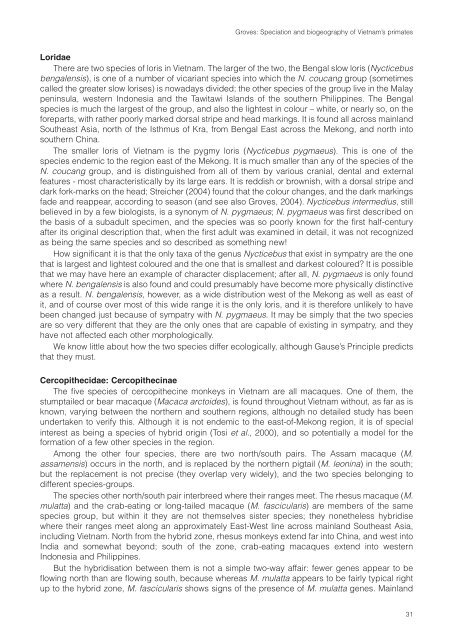Vietnamese Journal of Primatology - Frankfurt Zoological Society
Vietnamese Journal of Primatology - Frankfurt Zoological Society
Vietnamese Journal of Primatology - Frankfurt Zoological Society
Create successful ePaper yourself
Turn your PDF publications into a flip-book with our unique Google optimized e-Paper software.
Groves: Speciation and biogeography <strong>of</strong> Vietnam’s primates<br />
Loridae<br />
There are two species <strong>of</strong> loris in Vietnam. The larger <strong>of</strong> the two, the Bengal slow loris (Nycticebus<br />
bengalensis), is one <strong>of</strong> a number <strong>of</strong> vicariant species into which the N. coucang group (sometimes<br />
called the greater slow lorises) is nowadays divided; the other species <strong>of</strong> the group live in the Malay<br />
peninsula, western Indonesia and the Tawitawi Islands <strong>of</strong> the southern Philippines. The Bengal<br />
species is much the largest <strong>of</strong> the group, and also the lightest in colour – white, or nearly so, on the<br />
foreparts, with rather poorly marked dorsal stripe and head markings. It is found all across mainland<br />
Southeast Asia, north <strong>of</strong> the Isthmus <strong>of</strong> Kra, from Bengal East across the Mekong, and north into<br />
southern China.<br />
The smaller loris <strong>of</strong> Vietnam is the pygmy loris (Nycticebus pygmaeus). This is one <strong>of</strong> the<br />
species endemic to the region east <strong>of</strong> the Mekong. It is much smaller than any <strong>of</strong> the species <strong>of</strong> the<br />
N. coucang group, and is distinguished from all <strong>of</strong> them by various cranial, dental and external<br />
features - most characteristically by its large ears. It is reddish or brownish, with a dorsal stripe and<br />
dark fork-marks on the head; Streicher (2004) found that the colour changes, and the dark markings<br />
fade and reappear, according to season (and see also Groves, 2004). Nycticebus intermedius, still<br />
believed in by a few biologists, is a synonym <strong>of</strong> N. pygmaeus; N. pygmaeus was first described on<br />
the basis <strong>of</strong> a subadult specimen, and the species was so poorly known for the first half-century<br />
after its original description that, when the first adult was examined in detail, it was not recognized<br />
as being the same species and so described as something new!<br />
How significant it is that the only taxa <strong>of</strong> the genus Nycticebus that exist in sympatry are the one<br />
that is largest and lightest coloured and the one that is smallest and darkest coloured? It is possible<br />
that we may have here an example <strong>of</strong> character displacement; after all, N. pygmaeus is only found<br />
where N. bengalensis is also found and could presumably have become more physically distinctive<br />
as a result. N. bengalensis, however, as a wide distribution west <strong>of</strong> the Mekong as well as east <strong>of</strong><br />
it, and <strong>of</strong> course over most <strong>of</strong> this wide range it is the only loris, and it is therefore unlikely to have<br />
been changed just because <strong>of</strong> sympatry with N. pygmaeus. It may be simply that the two species<br />
are so very different that they are the only ones that are capable <strong>of</strong> existing in sympatry, and they<br />
have not affected each other morphologically.<br />
We know little about how the two species differ ecologically, although Gause’s Principle predicts<br />
that they must.<br />
Cercopithecidae: Cercopithecinae<br />
The five species <strong>of</strong> cercopithecine monkeys in Vietnam are all macaques. One <strong>of</strong> them, the<br />
stumptailed or bear macaque (Macaca arctoides), is found throughout Vietnam without, as far as is<br />
known, varying between the northern and southern regions, although no detailed study has been<br />
undertaken to verify this. Although it is not endemic to the east-<strong>of</strong>-Mekong region, it is <strong>of</strong> special<br />
interest as being a species <strong>of</strong> hybrid origin (Tosi et al., 2000), and so potentially a model for the<br />
formation <strong>of</strong> a few other species in the region.<br />
Among the other four species, there are two north/south pairs. The Assam macaque (M.<br />
assamensis) occurs in the north, and is replaced by the northern pigtail (M. leonina) in the south;<br />
but the replacement is not precise (they overlap very widely), and the two species belonging to<br />
different species-groups.<br />
The species other north/south pair interbreed where their ranges meet. The rhesus macaque (M.<br />
mulatta) and the crab-eating or long-tailed macaque (M. fascicularis) are members <strong>of</strong> the same<br />
species group, but within it they are not themselves sister species; they nonetheless hybridise<br />
where their ranges meet along an approximately East-West line across mainland Southeast Asia,<br />
including Vietnam. North from the hybrid zone, rhesus monkeys extend far into China, and west into<br />
India and somewhat beyond; south <strong>of</strong> the zone, crab-eating macaques extend into western<br />
Indonesia and Philippines.<br />
But the hybridisation between them is not a simple two-way affair: fewer genes appear to be<br />
flowing north than are flowing south, because whereas M. mulatta appears to be fairly typical right<br />
up to the hybrid zone, M. fascicularis shows signs <strong>of</strong> the presence <strong>of</strong> M. mulatta genes. Mainland<br />
31
















